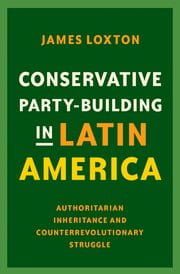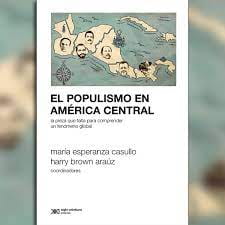A Review of Conservative Party-Building in Latin America: Authoritarian Inheritance and Counterrevolutionary Struggle

A Review of Conservative Party-Building in Latin America: Authoritarian Inheritance and Counterrevolutionary Struggle by James Loxton (Oxford University Press, 2021, pp. xxi+279).
Loxton focuses specifically on a subset of conservative political parties: “authoritarian successor parties” (ASPs), parties “that emerge from authoritarian regimes but that operate after a transition to democracy” (p. 2). He contrasts the longer-term electoral success of two conservative ASPs, Independent Democratic Union (Unión Demócrata Independiente, UDI) in Chile and Nationalist Republican Alliance (Alianza Republicana Nacionalista, ARENA) in El Salvador, with the shorter trajectories of two conservative parties without close ties to prior authoritarian regimes, Union of the Democratic Center (Unión del Centro Democrático, UCEDE) in Argentina and National Advancement Party (Partido de Avanzada Nacional, PAN) in Guatemala. All four of these parties were formed between 1981 and 1984.
Loxton demonstrates that UDI and ARENA entered democratic electoral competition with two important advantages based in their authoritarian-regime origins. First, both parties drew on an “authoritarian inheritance” in the form of an identifiable party brand, clientelist networks capable of mobilizing lower-class electoral support, a substantial territorial organization rooted in the preceding regime’s social programs (Chile) or rural paramilitary alliances (El Salvador) and sources of party finance.
Second, both UDI and ARENA were shaped by the “counterrevolutionary struggle” in which they engaged during their early histories. In Chile, UDI originated in mortal opposition to memories of the 1970-1973 Popular Unity government headed by Salvador Allende and the Socialist and Christian Democratic parties. Similarly in El Salvador, ARENA’s founders strenuously opposed the 1979 reformist military Revolutionary Governing Junta, and their party identity was strongly reinforced by later polarized electoral contestation with former armed-Left opponents in the Farabundo Martí National Liberation Front (FMLN). Legacies of counterrevolutionary struggle, Loxton maintains, created a strong sense of identity (mística) among both party leaders and members. This contributed significantly to internal party cohesion, which for a sustained period constituted an antidote against debilitating political schisms. In combination, Loxton persuasively argues, these two advantages made UDI and ARENA the most successful new conservative parties founded in Latin America during the period between 1978 and 2010.
In his introductory chapter, Loxton briefly considers four alternative explanations for variations in conservative party strength in Latin America since the 1980s: the size of the peasantry (a potential source of electoral support mobilized through patron-client ties), regional cleavages, religion (at least historically, conflicts over the role of the Roman Catholic Church sometimes generated durable mass support for conservative parties) and the historical strength of the political Right. He acknowledges that one or more of these elements has sometimes been significant in the development of particular parties, but he dismisses them as adequate explanations for the overall pattern of conservative party-building during the period under examination. Loxton notes, for example, that although Brazil’s Liberal Front Party successfully mobilized clientelist networks to generate support from the rural poor in the Northeast region during the late 1980s and 1990s, urbanization has over time substantially reduced the size of the rural electorate in many countries. Doctrinal change, shifts in the Church’s political alliances and a decline in Church membership in many Latin American countries have also diminished the importance of Catholic religiosity as a basis for contemporary conservative party-building.
The author effectively employs a research design featuring both “most similar” (Argentina-Chile, El Salvador-Guatemala) and “most different” (Chile-El Salvador) paired country comparisons. In outlining overall similarities and differences among these four cases, Loxton makes reference to electoral institutional arrangements, which are often a principal focus of research on political party systems and the incentives for (or obstacles to) political parties’ electoral success. They are especially relevant in the case of Chile, where outgoing government officials in the military dictatorship led by General Augusto Pinochet created a binomial electoral system as an institutional subsidy for rightist parties. Under the binomial system in effect until 2017, unless the party candidate list obtaining majority support won twice as many votes as the second rival list, one candidate from each list was seated in each two-member legislative district or constituency. Therefore, in the rivalry between the majority center-left Concert for Democracy (Concertación Democrática) and the rightist National Renovation/UDI coalition that dominated Chilean electoral politics for well over two decades, the binomial system in effect equalized legislative representation between the two contending blocs.
Loxton notes that the binomial system did play a substantial role in sustaining schism-prone National Renovation, Chile’s second conservative ASP. However, he maintains that it was not a major factor behind UDI’s electoral attainments. He is no doubt correct that UDI’s closer identification with the Pinochet legacy, its significantly greater internal cohesion and its privileged capacity to draw on municipal-level personal political networks dating from the dictatorship were all elements making it relatively less dependent on an institutional subsidy. Yet given that winning at least 10 percent of the votes cast in five consecutive legislative elections is Loxton’s principal measure of ASP success, it would certainly be worthwhile exploring in historical detail both where and how UDI won its initial legislative victories in the years after Chile’s democratic transition. The binomial system, as well as such institutional arrangements as gerrymandering of electoral districts, could well have made an important early contribution to building the party’s national legislative presence.
One puzzle that this book does not fully resolve concerns how electorally successful conservative ASPs managed the historical “authoritarian baggage” (p. 51) associated with the severe, extensive human rights violations often committed by the military-dominated regimes from which they originated. Although Loxton does not discuss this issue in the chapter on Guatemala, the PAN operated in an ethnically segmented society in which enduring memories of genocide against the Mayan population could well have constrained an elite-based party from building cross-class support and expanding its electoral base outside Guatemala City. He does note that UDI fared well electorally despite its enthusiastic embrace of the Chilean military’s “liberating action” on September 11, 1973, and Pinochet’s legacy. It would, however, be helpful to know more about what specific campaign and media strategies the party employed in this regard, particularly after Pinochet’s arrest in London in 1998 for internationally condemned human rights crimes.
Loxton frames his research questions broadly in terms of key debates regarding party-building and electoral politics in Latin America during the late 20th and early 21st centuries. He bases his four country case studies on an extensive examination of primary and secondary materials, and he admirably supplements those materials with interviews with conservative party leaders (cited simply as “national UDI leader,” “former PAN leader” and so forth) in Argentina, Chile, El Salvador and Guatemala. Labeling the interviewees more precisely would have avoided ambiguity concerning the number and the position of the individuals whose views Loxton solicited (did he interview the same “national UDI leader” on the different dates cited, or do different dates indicate interviews with more than one national UDI leader?). The interviews are, nonetheless, invaluable for the insights they offer into party leaders’ motivations and their perceptions of foundational events in the histories of conservative ASPs. Research of this kind is crucial to understanding how conservative political parties navigate the challenges they face in multiparty democratic electoral competition in contemporary Latin America.
Kevin J. Middlebrook is Professor of Latin American Politics at the Institute of the Americas, University College London. His most recent book is The International Defense of Labor Rights: Labor Standards, U.S. Trade Agreements, and State Sovereignty.
Related Articles
A Review of Born in Blood and Fire
The fourth edition of Born in Blood and Fire is a concise yet comprehensive account of the intriguing history of Latin America and will be followed this year by a fifth edition.
A Review of El populismo en América Latina. La pieza que falta para comprender un fenómeno global
In 1946, during a campaign event in Argentina, then-candidate for president Juan Domingo Perón formulated a slogan, “Braden or Perón,” with which he could effectively discredit his opponents and position himself as a defender of national dignity against a foreign power.
A Review of Aaron Copland in Latin America: Music and Cultural Politics
In Aaron Copland in Latin America: Music and Cultural Politics, Carol Hess provides a nuanced exploration of the Brooklyn-born composer and conductor Aaron Copland (1900–1990), who served as a cultural diplomat in Latin America during multiple tours.




